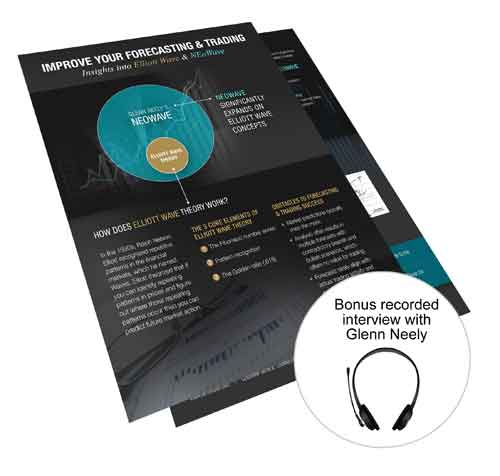NEoWave Blog
12/2/2019 - NEoWave Staff
Article #5 of 7: Glenn Neely answers an often-asked question about Elliott Wave Options
Introductory note: This is Part 5 of a 7-part series. In these articles, Glenn Neely, NEoWave founder and author of Mastering Elliott Wave, discusses Elliott Wave concepts from his unique point of view as a world-renowned Elliott Wave expert. In this frank, open, and insightful interview, Mr. Neely reveals his advanced forecasting and trading concepts – based on his decades of experience as the creator of NEoWave forecasting and his exciting Neely River Trading Technology, which fuels profitable trading results.
People often ask me about “Elliott Wave Options.” However, the actual question is how to apply Wave theory when you are trading Options. As I mentioned in the first article in this series, there are many advantages to trading Options. In fact, this strategy has significantly improved my trading results.
If you have read the first article in this series, then you know I’ve experienced a progression, because I began my career with the belief that Elliott Wave forecasting was the entire foundation of successful trading. Over time, I came to realize that forecasting is simply the first phase of a three-phase process. Today, trading Options figures strongly in my trading strategy. In fact, I didn’t even begin my study of Options until about 4 or 5 years ago. Previously, I avoided them, thinking they were almost like a con game and a bad idea. So I avoided the Options market completely until just a few years ago.
When I started studying the Options market, I didn’t focus on the traditional buy side, which is what the public normally gets involved in. The average person might not have a lot of money, but might be dreaming of riches! And Options, just like going to Vegas, has a temptation of “make a million dollars on a thousand dollars” – that kind of thing.
With Options, it’s definitely possible in the right situation, and the right circumstances, to have a market move a whole lot in just a few weeks. In rare situations, there is an unbelievable potential return if you’d bought Options in a specific market at a specific time. However, most of the time stocks don’t move dramatically, so you don’t get those incredible multiples.
Since stocks don’t normally make substantial moves quickly, there’s the hope – and then there’s the reality. Most people buy Options either AT the money or OUT of the money. In fact, most people probably buy them OUT of the money, because they want to spend a little bit and make a lot. Here’s an example of buying OUT of the money: Let’s say you’re buying an Option that’s at a strike of 100 and the stock you’re trading is at 90. That means the stock has to go before expiration of the Options. (Options expire every week, or every month, or every quarter, depending on what kind you buy.)
So let’s say you bought Options with one month to go. You bought the $100 strike. It’s trading at $90. That means it has to rally $10 – that’s 10% – just to get to 0. Okay? So, whatever money you spend on that Option, let’s say you spent $100, the stock would have to rally more than 10% for you to lose all your money. It would have to go up 20%. Then you’re going to make a lot of money. You would have spent $100, which would now be worth $1000. So you would make 10 times your money. But what are the chances of the stock going up 20% in a month? Not too good. Right?
That’s not a good way to trade Options. It’s a temptation that has been designed mostly to get a lot of people who are not professional traders to give the wealthier people their money. That’s really what the game is designed for. So, what the wealthier people do is they sell those Options to the public, and when they sell them it’s like collecting rent on an apartment building.
Let’s say you own an apartment building with 100 units. You’re not trying to sell the building. You’re not worrying if the price of real estate is going up or down. You’re only worried about, “I’m making $100 a month on each of those 100 units. How much will I earn per month, per year on that apartment building?” This is how you make passive income.
Over time, that passive income will more than pay for the entire real estate, so eventually the real estate is completely owned. You have no more debt and you own it outright, but you keep collecting rent on those 100 units.
While trading Options is more sophisticated, it’s a similar approach to using and leveraging money. Where you want to own the stock or you want to have what’s called a “deep in the money” call, that’s like owning the stock. Then you sell the calls on the other side, so you’re collecting “rent” on your position.
Here’s an example: To make it easy, let’s say you buy the stock at $90. Now you’re going to collect a certain amount of premium. It might be 1%, or 2%, or 3% per month. In this case, you might collect 90 cents, a dollar, $1.20, but you can do that potentially every month. You could collect 2% or 3% per month, so over a year’s time you could make 20%, 30%, 40% of the actual cost of the stock – while you still own the stock.
This means the stock could actually drop 50%, and you would still be at break even. That’s the way professional traders and investors use the Options market – not from the perspective of making a million dollars on a single $10,000 investment, but from a continuous “rental income” perspective, where you own the stock and you keep “renting” it out to people who want to make crazy gambles, hoping for a big move to happen over a short period of time. Meanwhile, you just continue to make money. So the stock can go up and you will make money on that. You can also make money by shorting the Option and make money on that. So you’re making money twice.
This is the way Options should be used. This strategy protects your position. You can make money when the market goes up, down, or sideways. In fact, now that I’m trading Options in the NEoWave Trading service, it has definitely smoothed out the performance.
Here’s another example: Let’s say you bought a stock at $90 in the past, and it has rallied to $100, and you sell that call at $100. You now have a situation where it could drop probably down to $95, and you would still have just as much money as you started when you bought the stock at $90. Now your break-even point has been moved from $90 to maybe $85, because you made $5 on writing the call.
So you got in at $90. It rallied to $100. You wrote the call (and made $5). The stock drops down to $95, but because of the money you collected from that call – and because the stock is actually still up $5 – you’d be up a total of $10 if it still was trading at $95. If it dropped to $90, you would still be ahead $5. This happens guaranteed over time, as long as we don’t get a massive bear market, which of course is always possible. But as long as you’re constantly writing Options premium on whatever core positions you have – and you do it every week, or every month, or year – it gets to the point where the stock could drop 50% and you would still be at a break-even point.
What I’ve learned through this process – including real-world trading in my customer account and my NEoWave Equity Fund account – is that, over time, you build a growing buffer of income that keeps adding to your bottom line. So even if the market takes a rollercoaster ride, there is an underlying, slow increase in value that’s occurring sort of below the radar. Over time, this allows you to have a buffer with nearly guaranteed protection against downside market action.
Right now [at the time this interview is being conducted], my fund is up over 30% for the last six months. A big part of that is because I’m constantly writing Option premium on the positions. Even though the market has been gyrating back and forth a lot the last year, my fund is actually up quite a bit.
Read the articles in this 7-part series:
Article #1,
Article #2,
Article #3,
Article #4,
Article #5,
Article #6,
Article #7,
Get 2 educational tools FREE!
Get Real-World Advice for Better Forecasts and Trades for FREE! Sign Up Now!
Learn more about:
NEoWave Trading Service
NEoWave Forecasting Service
Mastering Elliott Wave by Glenn Neely
Follow us @NEoWaveTheory:
Twitter: https://twitter.com/NEoWaveTheory
Facebook: https://www.facebook.com/NEoWaveTheory


